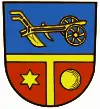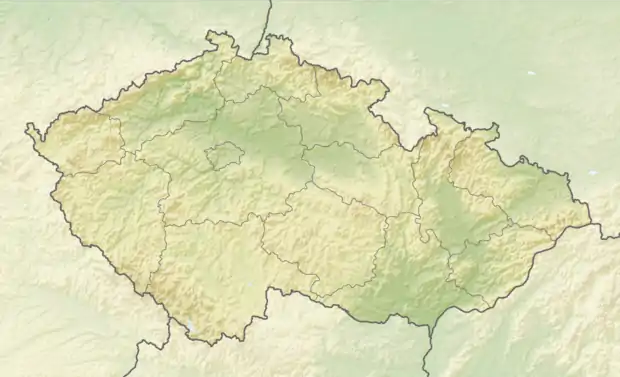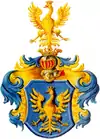Ropice
![]() Ropice (Polish:
Ropice (Polish: ![]() Ropica, German: Roppitz) is a municipality and village in Frýdek-Místek District in the Moravian-Silesian Region of the Czech Republic. It has about 1,700 inhabitants. Polish minority makes up 24.2% of the population.[2] Ropičanka River flows into the Olza in the municipality. It lies in the historical region of Cieszyn Silesia.
Ropica, German: Roppitz) is a municipality and village in Frýdek-Místek District in the Moravian-Silesian Region of the Czech Republic. It has about 1,700 inhabitants. Polish minority makes up 24.2% of the population.[2] Ropičanka River flows into the Olza in the municipality. It lies in the historical region of Cieszyn Silesia.
Ropice
Ropica | |
|---|---|
 Church of the Annunciation of the Virgin Mary | |
 Flag  Coat of arms | |
 Ropice Location in the Czech Republic | |
| Coordinates: 49°42′19″N 18°36′49″E | |
| Country | |
| Region | Moravian-Silesian |
| District | Frýdek-Místek |
| First mentioned | 1305 |
| Government | |
| • Mayor | Uršula Waniová (Polish: Urszula Wania) |
| Area | |
| • Total | 10.11 km2 (3.90 sq mi) |
| Elevation | 310 m (1,020 ft) |
| Population (2020-01-01[1]) | |
| • Total | 1,662 |
| • Density | 160/km2 (430/sq mi) |
| Time zone | UTC+1 (CET) |
| • Summer (DST) | UTC+2 (CEST) |
| Postal code | 739 56 |
| Website | www |
History
Ropice was first mentioned in a Latin document of Diocese of Wrocław called Liber fundationis episcopatus Vratislaviensis from around 1305 as item in Ropiza.[4][5][6][7] It meant that the village was in the process of location (the size of land to pay a tithe from was not yet precised). The creation of the village was a part of a larger settlement campaign taking place in the late 13th century on the territory of what will be later known as Upper Silesia.
Politically Ropice belonged initially to the Duchy of Teschen, formed in 1290 in the process of feudal fragmentation of Poland and was ruled by a local branch of Piast dynasty. In 1327 the duchy became a fee of the Kingdom of Bohemia, which after 1526 A.D became part of the Habsburg Monarchy.
The village became a seat of a Catholic parish, mentioned in the register of Peter's Pence payment from 1447 among 50 parishes of Teschen deanery as Ropicza.[8] After the 1540s Protestant Reformation prevailed in the Duchy of Teschen and a local Catholic church was taken over by Lutherans. It was taken from them (as one from around fifty buildings in the region) by a special commission and given back to the Roman Catholic Church on 26 March 1654.[9]
Owners of Ropica in the 15th century, the Sobek family, built a fort in the village. It was rebuilt to a baroque château around 1700 and then to a classicist one in 1810. It remains in that style today, although it dilapidated during the communist era and is now completely devastated.
After Revolutions of 1848 in the Austrian Empire a modern municipal division was introduced in the re-established Austrian Silesia. The village as a municipality was subscribed to the political and legal district of Cieszyn. According to the censuses conducted in 1880, 1890, 1900 and 1910 the population of the municipality grew from 1,158 in 1880 to 1,289 in 1910 with a majority being native Polish-speakers (between 95.5% and 97.8%) accompanied by a small German-speaking minority (at most 39 or 3% in 1910) and Czech-speaking people (at most 19 or 1.5% in 1910). In terms of religion in 1910 the majority were Roman Catholics (53%), followed by Protestants (47%).[10] Ropice was also traditionally inhabited by Cieszyn Vlachs, speaking Cieszyn Silesian dialect.
After World War I, fall of Austria-Hungary, Polish–Czechoslovak War and the division of Cieszyn Silesia in 1920, it became a part of Czechoslovakia. Following the Munich Agreement, in October 1938 together with the Zaolzie region it was annexed by Poland, administratively adjoined to Cieszyn County of Silesian Voivodeship.[11] It was then annexed by Nazi Germany at the beginning of World War II. After the war it was restored to Czechoslovakia.
Sport
There is a modern golf course in Ropice.
Gallery
 Dilapidated château
Dilapidated château.jpg.webp) Dilapidated château in 2012
Dilapidated château in 2012 Church of the Annunciation of the Virgin Mary
Church of the Annunciation of the Virgin Mary Church of the Annunciation of the Virgin Mary
Church of the Annunciation of the Virgin Mary Lutheran cemetery with chapel
Lutheran cemetery with chapel
References
- "Population of Municipalities – 1 January 2020". Czech Statistical Office. 2020-04-30.
- "Public database: Census 2011". Czech Statistical Office. Retrieved 2020-10-18.
- Mrózek, Robert (1984). Nazwy miejscowe dawnego Śląska Cieszyńskiego [Local names of former Cieszyn Silesia] (in Polish). Katowice: University of Silesia in Katowice. p. 151. ISSN 0208-6336.
- Panic, Idzi (2010). Śląsk Cieszyński w średniowieczu (do 1528) [Cieszyn Silesia in Middle Ages (until 1528)] (in Polish). Cieszyn: Starostwo Powiatowe w Cieszynie. pp. 297–299. ISBN 978-83-926929-3-5.
- Schulte, Wilhelm (1889). Codex Diplomaticus Silesiae T.14 Liber Fundationis Episcopatus Vratislaviensis (in German). Breslau.
- "Liber fundationis episcopatus Vratislaviensis" (in Latin). Retrieved 13 July 2014.
- Hosák, Ladislav; Rudolf Šrámek (1980). Místní jména na Moravě a ve Slezsku II, M-Ž (in Czech). Praha: Academia. p. 377.
- "Registrum denarii sancti Petri in archidiaconatu Opoliensi sub anno domini MCCCCXLVII per dominum Nicolaum Wolff decretorum doctorem, archidiaconum Opoliensem, ex commissione reverendi in Christo patris ac domini Conradi episcopi Wratislaviensis, sedis apostolice collectoris, collecti". Zeitschrift des Vereins für Geschichte und Alterthum Schlesiens (in German). Breslau: H. Markgraf. 27: 361–372. 1893. Retrieved 21 July 2014.
- Broda, Jan (1992). "Materiały do dziejów Kościoła ewangelickiego w Księstwie Cieszyńskim i Państwie Pszczyńskim w XVI i XVII wieku". Z historii Kościoła ewangelickiego na Śląsku Cieszyńskim (in Polish). Katowice: Dom Wydawniczy i Księgarski „Didache“. pp. 259–260. ISBN 83-85572-00-7.
- Piątkowski, Kazimierz (1918). Stosunki narodowościowe w Księstwie Cieszyńskiem (in Polish). Cieszyn: Macierz Szkolna Księstwa Cieszyńskiego. pp. 265, 283.
- "Ustawa z dnia 27 października 1938 r. o podziale administracyjnym i tymczasowej organizacji administracji na obszarze Ziem Odzyskanych Śląska Cieszyńskiego". Dziennik Ustaw Śląskich (in Polish). Katowice. nr 18/1938, poz. 35. 31 October 1938. Retrieved 1 July 2014.
- "Družební obce". ropice.cz (in Czech). Obec Ropice. Retrieved 2020-11-04.
- Cicha, Irena; Jaworski, Kazimierz; Ondraszek, Bronisław; Stalmach, Barbara; Stalmach, Jan (2000). Olza od pramene po ujście. Český Těšín: Region Silesia. ISBN 80-238-6081-X.


